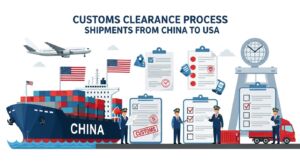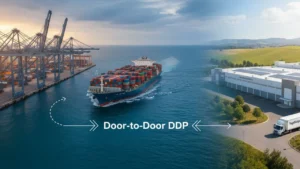Freight shipping is the process of transporting goods, commodities, and cargo by land, sea, or air.
It plays a vital role in global trade, connecting manufacturers, suppliers, and consumers worldwide.
From small packages to large cargo containers, freight shipping services handle a wide range of products, ensuring timely delivery and efficient logistics.
With various options like full truckload, less-than-truckload, and intermodal shipping, businesses can choose the most cost-effective and reliable method to meet their needs.
Understanding freight shipping is essential for navigating the complexities of today’s interconnected marketplace.
What is Freight Shipping?
Freight shipping, also known as freight transportation, involves moving large quantities of goods, commodities, or cargo from one location to another, anywhere in the world. This can be done through various modes, including air, ocean, ground, rail, or a combination known as intermodal shipping.
The key difference between freight and small package shipping lies in the weight of the shipment. If your shipment weighs 150 pounds or less, it is classified as a small package. However, if it weighs more than 150 pounds and up to 15,000 pounds, it is considered freight. For a few parcels, traditional small package shipping is sufficient. But for larger shipments or a high volume of goods, freight shipping is the preferred method.
Freight shipping is versatile and can accommodate a wide range of goods, making it a reliable choice for businesses with varying shipping needs. There’s virtually no limit to what can be shipped via freight, making it an essential part of global trade and commerce.

Importance of Freight Shipping in Global Trade
Freight shipping is crucial to global trade, enabling the seamless movement of goods across borders and continents. It supports the supply chains of countless industries, from manufacturing to retail, ensuring products reach markets efficiently and reliably. By connecting producers and consumers worldwide, freight shipping drives economic growth, supports international commerce, and fosters global partnerships. Its importance in facilitating trade and keeping the global economy running smoothly cannot be overstated.

Types of Freight
General Cargo
General cargo refers to goods that are individually packaged and shipped, such as boxes, pallets, or crates. These items are typically transported in standard shipping containers or on pallets, and include a wide range of products like machinery, electronics, and textiles, which do not require special handling.
Bulk Cargo
Bulk cargo consists of large quantities of unpackaged goods transported in large volumes, such as grains, coal, oil, and minerals. These commodities are typically shipped in bulk carriers or tankers and are handled using special equipment for loading and unloading, like conveyor belts or pumps.
Containerized Freight
Containerized freight involves transporting goods in standardized containers, usually 20 or 40 feet in length. This method simplifies loading, unloading, and transferring cargo between different transportation modes, such as ships, trucks, and trains, providing enhanced security, efficiency, and protection for a wide variety of goods.
Specialized Freight
Specialized freight includes cargo that requires special handling, packaging, or transportation due to its nature, such as hazardous materials, perishable goods, oversized loads, or temperature-sensitive items. This freight often requires specialized containers, equipment, and compliance with strict regulations to ensure safe and secure transport.
Best Practices for Cargo Freight Shipping
To ensure successful cargo freight shipping, follow best practices such as selecting the appropriate shipping method and packaging goods securely to prevent damage. Proper documentation, including accurate labeling and customs paperwork, is essential for smooth transit. Collaborate with reliable carriers and utilize tracking technology to monitor shipments. Finally, understanding regulations and ensuring compliance helps avoid delays and additional costs, making the shipping process efficient and hassle-free.

Types of Freight Shipping Methods
Less Than Truckload (LTL) Shipping
LTL shipping is used for smaller shipments that don’t require a full truck. Multiple shipments from different customers are combined into one truck, reducing costs. It’s ideal for businesses with smaller loads, offering flexibility and cost savings while sharing transportation costs with other shippers.
Full Truckload (FTL) Shipping
FTL shipping involves a dedicated truck for a single shipment, typically used when cargo fills an entire truck or requires exclusive transport. It is faster than LTL since it travels directly from origin to destination without multiple stops, making it ideal for large or sensitive shipments.
Intermodal Shipping
Intermodal shipping utilizes multiple modes of transportation, such as trucks, trains, and ships, to move goods efficiently over long distances. Containers are transferred seamlessly between different transport modes without handling the cargo itself, reducing costs and environmental impact while providing flexibility and enhanced security.
Air Freight
Air freight is the transportation of goods by aircraft, offering the fastest shipping option for time-sensitive or high-value items. It provides reliable and quick delivery over long distances but is typically more expensive than other methods due to higher fuel and operational costs.
Sea Freight
Sea freight involves transporting large volumes of goods by cargo ships across oceans. It is the most cost-effective method for heavy, bulky, or non-urgent shipments. Though slower than air freight, it is ideal for international trade, especially for goods that do not require quick delivery.
Rail Freight
Rail freight uses trains to transport goods over long distances, particularly for heavy, bulk, or large shipments. It is more cost-effective and environmentally friendly than road transport and is ideal for shipping large volumes of goods across continents, especially in regions with well-established rail networks.

Comparison of Different Freight Shipping Modes
Sea Freight vs Air Freight:
Sea freight is cost-effective for large, bulky shipments with longer delivery times, suitable for non-urgent cargo. Air freight offers fast delivery for time-sensitive or high-value items but at a higher cost. Sea freight is ideal for bulk shipments over long distances, while air freight excels in speed and reliability for urgent deliveries.
Road Freight vs Rail Freight:
Road freight provides flexibility and door-to-door service, making it ideal for shorter distances and diverse cargo types. Rail freight is cost-effective for heavy, bulk shipments over long distances, offering larger capacity and less environmental impact. Road freight suits local and regional transport, while rail is better for extensive, long-haul routes.
Choosing the Right Mode of Transport Based on Cost, Speed, and Cargo Type:
Selecting the appropriate transport mode involves balancing cost, speed, and cargo characteristics. Sea freight is economical for bulky goods but slow, while air freight is fast but expensive. Road freight offers flexibility for short distances, and rail freight is efficient for heavy, long-distance shipments. Choose based on your shipment’s urgency, budget, and nature.
Freight Shipping Rates
Factors That Affect Freight Shipping Rates
The freight rate is influenced by several factors, including distance and destination, cargo class and density, cargo weight and volume, and the chosen transportation method. Additional factors such as fuel surcharges, seasonal demand and special freight charges also affect the overall cost of transporting goods. We will mention some of these items below

Distance and Destination
The farther the distance and the more remote the destination, the higher the freight shipping rates. Shipping internationally or to hard-to-reach areas also increases costs due to longer transit times and additional logistical challenges.
Freight Class and Density
Freight class, determined by the cargo’s density, stowability, handling, and liability, affects shipping rates. Lower-density goods take up more space, leading to higher costs, while higher-density goods cost less to ship.
Weight and Volume
The weight and volume of a shipment significantly impact rates. Heavier and bulkier shipments cost more due to the space they occupy and the additional fuel and handling required.
Mode of Transportation
The choice between air, sea, road, rail, or intermodal shipping influences rates. Air freight is the most expensive due to speed and fuel costs, while sea and rail are more economical for large, less time-sensitive shipments.
Fuel Surcharges and Additional Fees
Fluctuating fuel prices affect shipping rates through fuel surcharges. Additional fees for services like residential delivery, lift-gate services, or special handling can also increase the total shipping cost.
How Freight Rates Are Calculated
Freight rates are calculated based on factors like distance, weight, volume, freight class, mode of transport, and any additional services or fees required. Carriers consider these elements to provide an accurate quote for shipping costs.

Tips for Reducing Freight Shipping Costs
Consolidating Shipments:
Combining multiple smaller shipments into a single larger one reduces transportation costs and maximizes cargo space. This approach minimizes the number of shipments and can lead to bulk discounts from carriers, making it more cost-effective, particularly for businesses with regular, smaller consignments.
Optimizing Packaging to Reduce Volume and Weight:
Efficient packaging minimizes excess weight and reduces shipment volume, directly lowering shipping costs. By using smaller, lighter packaging materials and maximizing space within containers, businesses can reduce dimensional weight charges and minimize the risk of damage, leading to lower shipping fees and better protection of goods.
Negotiating with Freight Carriers:
Negotiating directly with freight carriers can secure better rates and service terms. Establishing strong relationships and leveraging shipment volume or long-term contracts can result in discounted rates, priority service, or added value services, ultimately reducing overall shipping costs.
Leveraging Freight Forwarders and Brokers:
Freight forwarders and brokers act as intermediaries between shippers and carriers, leveraging their networks and expertise to find the best rates and routes. They handle logistics, negotiate prices, and provide value-added services, simplifying the shipping process and potentially reducing costs for businesses.
Choosing the Right Mode of Transport:
Selecting the most appropriate mode of transport—whether air, sea, rail, or road—based on shipment size, urgency, and budget, optimizes costs and efficiency. Each mode has its advantages, and choosing wisely ensures timely delivery while balancing speed and expense.
Using Technology and Freight Management Software:
Utilizing freight management software helps automate and optimize the shipping process. These tools provide real-time tracking, rate comparisons, route optimization, and data analytics, enhancing decision-making, improving efficiency, and reducing costs by managing logistics more effectively.
Topshipping – Your partner in your freight
Freight Shipping Requirements
Documentation Needed for Freight Shipping
Essential documentation includes the bill of lading, which details the cargo and terms of transport, the commercial invoice for customs and accounting purposes, and a packing list outlining the contents of each shipment. Accurate and complete documentation ensures smooth processing, minimizes delays, and facilitates effective communication between parties.
Packing and Labeling Requirements
Proper packing and labeling are crucial for safe transport and efficient handling. Goods should be securely packed to prevent damage, with clear labeling that includes essential details like handling instructions, destination address, and hazardous material warnings. Adhering to these requirements helps ensure compliance and facilitates smooth transit and delivery.
Customs and Regulatory Compliance for International Freight Shipping
Compliance with customs regulations involves accurate documentation, tariff classification, and adherence to import/export laws. Shippers must provide necessary paperwork such as commercial invoices and certificates of origin, and ensure their goods meet the destination country’s regulations. Proper compliance avoids delays, penalties, and ensures smooth international shipping.
Topshipping – Your partner in your freight
The most important step to a great experience is working with a freight forwarder company. it is a tricky game and you should get help from a professional.
It does not matter if you carry cargo by plane, truck or ship. Topshipping manages your entire shipping process. It also offers the best rates based on your product and needs. So, ready to get freight shipping quote?
Customs Clearance
The import and export laws of different countries are different. Some countries prevent the import of some goods. Some have their own side effects. So, it is very important that you are familiar with the laws of the destination country. Because in case of delay and violation, it will have serious consequences for you.
For example, in shipping from China to USA
: goods and documents are checked and then duties and taxes are levied. In US customs you face duties such as ISF, import duty and penalties charges.

Final Takeaway
Choosing the right mode of transport is crucial for optimizing freight shipping based on cost, speed, and cargo type. Sea freight is best for large, non-urgent shipments, while air freight suits high-value, time-sensitive goods. Road and rail freight each offer unique advantages depending on distance and cargo needs. Understanding these factors and leveraging efficient practices ensure cost-effective and timely delivery, ultimately supporting smoother logistics and business operations.














